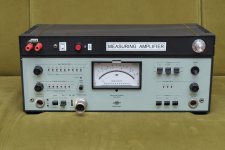Try increasitng both the integration time and intra burst delay to 2x or 3x the value. Maybe your soundcard just does not like so short pauses between each frequency sine burst.
No change I'm afraid. It still hangs after a seemingly random period of time.
Then I have to click "Stop Measurement" to regain control of the application.
Current best, affordable, tested USB soundcard with one mic input for ARTA? (SPL, Impedance)
The RTX6001 is phantastic 😀
(ok, that's probably not what you mean with "affordable")
I work with Maya 22 usb; it makes the job; enough for what I need _ DIY speakers and headphones mods measurements.😉What about Maya22 usb - anyone?
I was using Maudio Transit, it worked ok but willing to upgrade. Selling my Bruel Kjaer 2610 with mic and computer. Upgrading to 2690.
Hello, very good side with quality reviews ProSound: ???????????????? ????
What about Maya22 usb - anyone?
For me Maya22 USB wasn't success. While very convenient it tended to oscillate after some usage time in 24/96 mode. Perhaps particular unit or batch was defective. When I noticed that, it was too late to send for replacement. ESI support was dead silent after inquiry.
I'm happy with Roland Quad Capture. Loopback measurement did show that it has linear bandwidth up to 88kHz (in 192kHz mode), which was quite a surprise.
For me Maya22 USB wasn't success. While very convenient it tended to oscillate after some usage time in 24/96 mode. Perhaps particular unit or batch was defective. When I noticed that, it was too late to send for replacement. ESI support was dead silent after inquiry.
I'm happy with Roland Quad Capture. Loopback measurement did show that it has linear bandwidth up to 88kHz (in 192kHz mode), which was quite a surprise.
Plus Roland Quad Capture has SPDIF digital output. If your rig has digital input, one A/D conversion can be eliminated, which often is an audible benefit. Easily switchable from analog to digital output in both ARTA and Windows. Supports ASIO.
I bought a Behringer UMC202HD and the overall (loopback) distortion is higher than expected due to the input stage of the preamp. Then I've got a Foscusrite Scarlett Solo for maybe $50 used, and all is right.
How to change impulse response uV/V to mV/V?
How to change impulse response uV/V to mV/V in the impulse response graph?
How to change impulse response uV/V to mV/V in the impulse response graph?
How to change impulse response uV/V to mV/V in the impulse response graph?
Done, not need help. Used too much gain.
I bought a Behringer UMC202HD and the overall (loopback) distortion is higher than expected due to the input stage of the preamp. Then I've got a Foscusrite Scarlett Solo for maybe $50 used, and all is right.
What would be the smallest one? As small as Intel Compute Stick.
What would be the smallest one? As small as Intel Compute Stick.
The Focusrite is smaller, you can look up the dimensions on the Internet, but I don't know what you mean by stick; if you think thumbdrive, then not way, they're much bigger.
Yes like a stick - crazy plan put Intel Compute Stick, soundcard and Anaview into Kjaer 2690 Nexus amp.
The input stage of the preamp is a balanced input, if you feed it with an unbalanced signal like the output in a loopback test 2nd harmonic distortion will be higher.I bought a Behringer UMC202HD and the overall (loopback) distortion is higher than expected due to the input stage of the preamp. Then I've got a Foscusrite Scarlett Solo for maybe $50 used, and all is right.
So either use it with unbalanced input signals as it is designed for, or use the insert input on the rear which is unbalanced and bypasses the preamps.
You can get perfect loopback performance using the insert input with distortion that is too low to measure. (For example if using an impedance measuring jig)
It's the UMC204HD that has the inserts; sadly I didn't look carefully enough, cheaped out on this deal and got the 202 that doesn't have them. But the Focusrite is fine now.
Yes like a stick - crazy plan put Intel Compute Stick, soundcard and Anaview into Kjaer 2690 Nexus amp.
Then no luck, both the Behringer and the Focusrite are sizable boxes. But then again, they have the XLR connectors and phantom power, convenient for measuring with a microphone.
Ah ok, bad news.It's the UMC204HD that has the inserts; sadly I didn't look carefully enough, cheaped out on this deal and got the 202 that doesn't have them. But the Focusrite is fine now.
The insert inputs on my UMC204HD work great with line level unbalanced signals. No measurable distortion (below the noise floor) and noise levels are lower as well.
The pre-amp inputs work fine with a balanced signal - for example a balanced XLR microphone or for measuring crossover outputs I use a small audio transformer to isolate and convert to balanced.
The pre-amp inputs are servo balanced so do work with an unbalanced signal but this generates quite significant 2nd harmonic distortion - not enough to be audible, but enough to make it no use as a measurement tool for distortion measurements.
Ah ok, bad news...
Not really. 🙂
I'm a tube guy, so I need the high impedance of the instrument input, so the Focusrite is alright.
